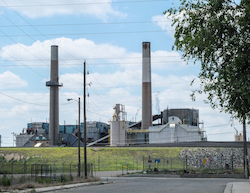2014 News & Events
New findings show U.S. power plant emissions are down
9 January 2014
modified from the joint release by AGU and CIRES Communications

Scientists report that the switch to natural gas power plants means fewer air pollutants.
Power plants that use natural gas and a new technology to squeeze more energy from the fuel release far less of the greenhouse gas carbon dioxide than coal-fired power plants do, according to a new analysis accepted for publication in the journal Earth's Future, a journal of the American Geophysical Union. The so-called "combined cycle" natural gas power plants also release significantly less nitrogen oxides and sulfur dioxide, which can worsen air quality.
"Since more and more of our electricity is coming from these cleaner power plants, emissions from the power sector are lower by 20, 30, even 40 percent for some gases, since 1997," said lead author Joost de Gouw, a CSD atmospheric scientist with NOAA's Cooperative Institute for Research in Environmental Sciences (CIRES) at the University of Colorado Boulder.
De Gouw and his NOAA and CIRES colleagues analyzed data from systems that continuously monitor emissions at power plant stacks around the country. Previous aircraft-based studies have shown these stack measurements are accurate for carbon dioxide (CO2) and for nitrogen oxides and sulfur dioxide.
Nitrogen oxides and sulfur dioxide can react in the atmosphere to form tiny particles and ozone, which can cause respiratory disease.
To compare pollutant emissions from different types of power plants, the scientists calculated emissions per unit of energy produced, for all data available between 1997 and 2012. During that period of time, on average:
- Coal-based power plants emitted 915 grams (32 ounces) of CO2 per kilowatt hour of energy produced;
- Natural gas power plants emitted 549 grams (19 ounces) CO2 per kilowatt hour; and
- Combined cycle natural gas plants emitted 436 grams (15 ounces) CO2 per kilowatt hour.
In combined cycle natural gas plants, operators use two heat engines in tandem to convert a higher fraction of heat into electrical energy. For context, U.S. households consumed 11,280 kilowatt hours of energy, on average, in 2011, according to theU.S. Energy Information Agency. This amounts to 11.4 metric tons per year of CO2 per household, if all of that electricity were generated by a coal power plant, or 5.4 metric tons if it all came from a natural gas power plant with combined cycle technology.
The researchers reported that between 1997 and 2012, the fraction of electric energy in the United States produced from coal gradually decreased from 83 percent to 59, and the fraction of energy from combined cycle natural gas plants rose from none to 34 percent.

That shift in the energy industry meant that power plants, overall, sent 23 percent less CO2 into the atmosphere last year than they would have, had coal been providing about the same fraction of electric power as in 1997, de Gouw said. The switch led to even greater reductions in the power sector's emissions of nitrogen oxides and sulfur dioxide, which dropped by 40 percent and 44 percent, respectively.
The new findings are consistent with recent reports from the Energy Information Agency that substituting natural gas for coal in power generation helped lower power-related carbon dioxide emissions in 2012.
The authors noted that the new analysis is limited to pollutants emitted during energy production and measured at stacks. The paper did not address levels of greenhouse gases and other pollutants that leak into the atmosphere during fuel extraction, for example. To investigate the total atmospheric consequences of shifting energy use, scientists need to continue collecting data from all aspects of energy exploration, production and use, the authors concluded.
Authors of the new paper, Reduced emissions of CO2, NOx and SO2 from U.S. power plants owing to switch from coal to natural gas with combined cycle technology, are Joost de Gouw (NOAA ESRL CSD and CIRES), David Parrish (NOAA ESRL CSD), Greg Frost (NOAA ESRL CSD and CIRES), and Michael Trainer (NOAA ESRL CSD).
J. de Gouw, D. Parrish, G. Frost, and M. Trainer, Reduced emissions of CO2, NOx and SO2 from U.S. power plants owing to switch from coal to natural gas with combined cycle technology, Earth's Future, doi:10.1002/2014EF000196, 2014.
Abstract
Since 1997, an increasing fraction of electric power in the U.S. has been generated from natural gas. Here, we use data from continuous emissions monitoring systems (CEMS), which measure emissions at the stack of most U.S. electric power generation units, to investigate how this switch affected the emissions of CO2, NOx and SO2. Per unit of energy produced, natural gas power plants equipped with combined cycle technology emit on average 44% of the CO2 compared with coal power plants. As a result of the increased use of natural gas, CO2 emissions from U.S. fossil-fuel power plants were 23% lower in 2012 than they would have been, if coal had continued to provide the same fraction of electric power as in 1997. In addition, natural gas power plants with combined cycle technology emit less NOx and far less SO2 per unit energy produced than coal power plants. The increased use of natural gas has therefore led to emissions reductions of NOx (40%) and SO2 (44%), in addition to those obtained from the implementation of emissions control systems on coal power plants. These benefits to air quality and climate should be weighed against the increase in emissions of methane, volatile organic compounds and other trace gases that are associated with the production, processing, storage and transport of natural gas.